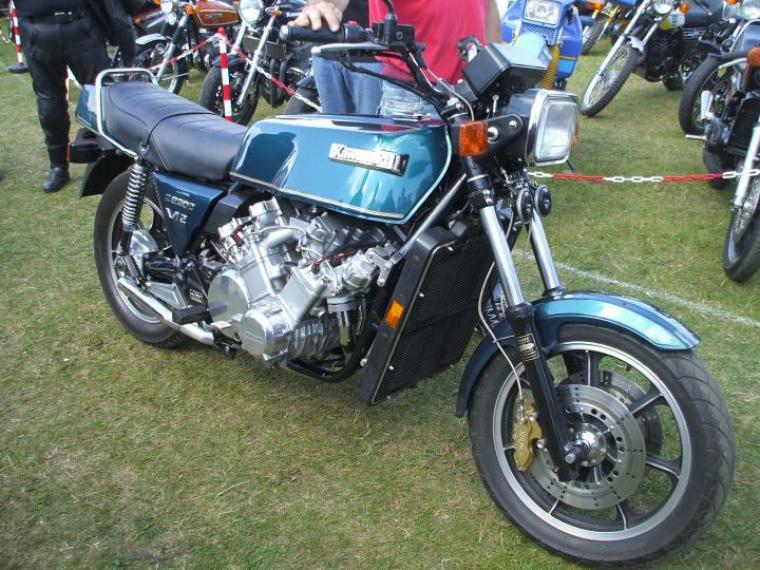Kawasaki V12 2300cc Pictures
Add Your Photos!Thanks to Bob Story for these pictures of an amazing machine. He took the pictures at at the Popham bike jumble in 2009. This is a creation by British special bike builder Alan Millyard. He has built loads of specials, all with extreme care and detail. These pictures are of a Kawasaki based V12 2300cc bike. And Bob has also found these words on the creator (all due credit to whoever wrote this)
~Adding more cylinders to motorcycle engines is no mean feat, but one man does it again and again. Allen Millyard is keen on motorcycles in the same way you might say the Pope is keen on religion. In Allen’s lounge, where you might expect to find a coffee table, he keeps a big Suzuki and a 1,000cc Kawasaki. They have to go there, because a brand new motocrosser has just arrived in the dining room. And if you think that’s strange, wait until you see the Gilera, Malaguti and Hondas upstairs…
Sharing house space with motorcycles is quite common among enthusiasts, but the bikes in his house are special. That coffee table Kawasaki is a four-cylinder two-stroke, while the first-floor Honda is powered by a 100cc V-twin. Neither was ever available from the manufacturer.
Curiouser and curiouser; in the garage you’ll find a 1,600cc V8 and a magnificent, 2,300cc V12. Both wear Kawasaki badges, but again the original manufacturer never offered anything so adventurous. One started life as a 1,000cc in-line four, the other as a 1,300cc six. All have been created by Allen, the V12 being the latest in a career that began as a teenager when he bundled a Mini engine into a BSA frame.
An early fascination with Kawasaki two-strokes resulted in the conception of in-line four-, five- and six-cylinder engines based on factory-made triples. Without wishing to make the task seem any less than formidable, adding extra cylinders to an air-cooled two-stroke was simple compared with later projects.
Allen then turned his attention to four-strokes, transforming an unsuspecting 50cc Honda single into the V-twin now parked in his bedroom. And he did it in a weekend, in front of an audience at a bike show. Then came the amazing V8. As usual, no drawings were made, all design work takes place inside his head followed by hundreds of hours of graft.
To keep overall length to a minimum, the cylinder banks were spaced at 70 degrees, rather than the usual right-angle. The crankshaft is fairly standard, using two thinned-down con-rods on each throw. Having the cylinder banks out of line wasn’t aesthetically acceptable to Allen, so he made up new cylinder liners with offset bores of smaller size. Thus, the engine displaces slightly less than twice its four-cylinder capacity, but is symmetrically beautiful outside.
Glossing over things like reversing the rear cylinder head, designing the camshaft drive to suit, making carburettor manifolds and exhausts and lengthening the Kawasaki frame by five inches so that the engine could be accommodated without the forward cylinders fouling the front wheel, among others, that was about that.
The V8 clocked up many thousands of trouble-free miles. It has been toured throughout Europe, thrashed round racetracks and even secured a win at a sprint in the Isle of Man on a visit to the TT. Estimated power is about 130bhp at 8,000rpm and the bike weighs about 88lb more than its Z1 progenitor.
Naturally, his next project was inspired by someone saying that it would be impossible. The starting point was the Kawasaki Z1300 six, a monster of a bike introduced in 1979. Although turning this into a V12 employed the same technique as the V8, the Z1300′s unusual layout made the job an even greater challenge.
Describing the process would fill an entire issue of Telegraph Motoring, but rest assured, it wasn’t easy. For months on end, after a full day working as an engineer for the MoD, Allen would disappear into his small garage for another five hours, sculpting a new set of crankcases. The cylinders were again offset by 70 degrees, but this time with both banks at 35 degrees to vertical.
Which is where it all gets complicated, because the Kawasaki engine has a two-stage camshaft drive, a three-stage transmission drive and narrow plain bearings with no room for side-by-side con-rods. Undaunted, everything was reworked, adding secondary con-rods and incorporating roller bearings with a low-pressure, high-volume lubrication system.
As with the V8, the original chassis needed lengthening, this time by about four inches – and that included the fuel tank. How? Well, saw it in two and splice in a new section.
Even on close inspection all these Millasakis look as if they could be production models. It’s engineering; and it’s art. I would nominate the V12 for a Turner Prize, but since imagination, skill and effort were involved, it obviously doesn’t qualify.”






